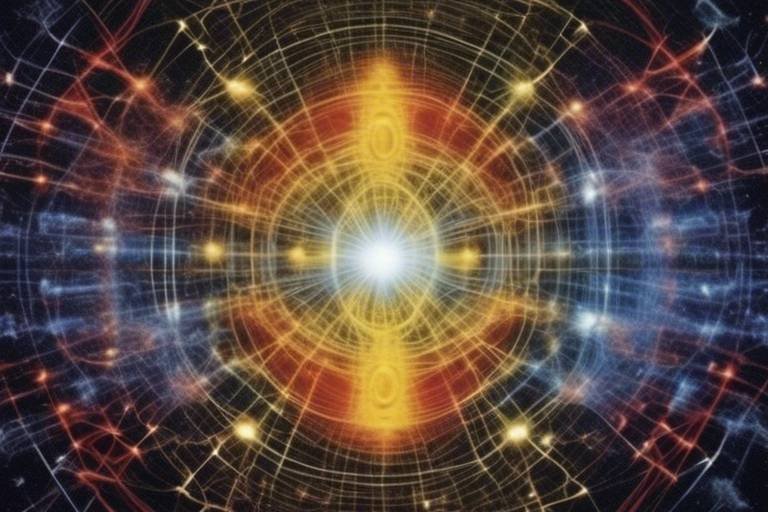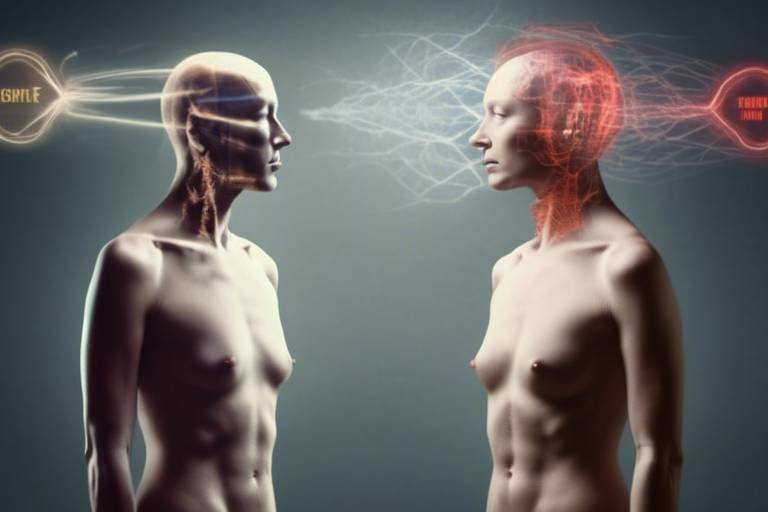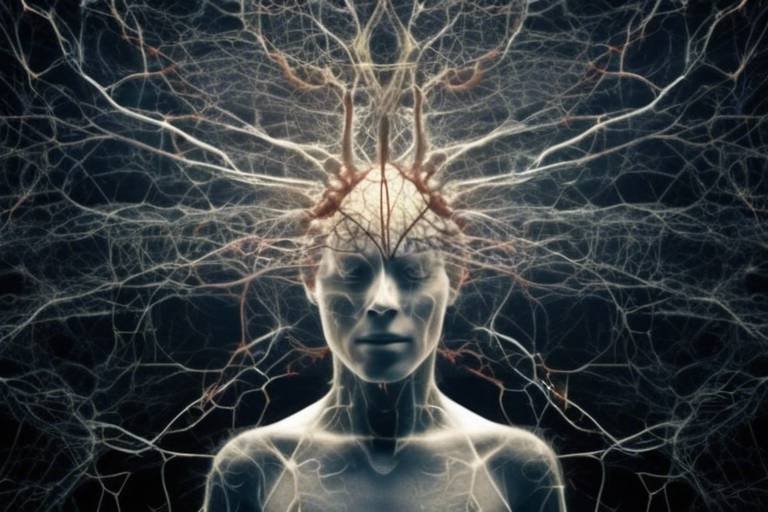Mind and Consciousness - A Neuroscientific Perspective
The relationship between mind and consciousness is one of the most profound and enigmatic topics in neuroscience today. As we delve into this intricate web, we uncover layers of understanding that not only challenge our perceptions but also enrich our grasp of human cognition and behavior. Imagine consciousness as a vast ocean, with the mind as a tiny boat navigating its depths. What lies beneath the surface? What mysteries await? These questions propel us into the heart of neuroscientific inquiry, where researchers are tirelessly working to decode the complexities of our mental experiences.
At its core, consciousness can be seen as the awareness of our thoughts, feelings, and surroundings. It is the spotlight that illuminates our experiences, allowing us to engage with the world in a meaningful way. However, defining consciousness is no easy feat. Philosophers and scientists alike have grappled with its essence, leading to a multitude of perspectives. Some argue that consciousness is a byproduct of brain activity, while others posit that it is a fundamental aspect of reality itself. This ongoing debate is akin to trying to catch smoke with your bare hands—elusive and ever-changing.
Neuroscience offers a unique lens through which we can examine consciousness. By investigating the brain's inner workings, we can begin to understand how various regions and networks contribute to our conscious experiences. Recent research has illuminated the neural correlates of consciousness, revealing that certain brain areas are activated during specific mental states. These findings not only deepen our understanding of consciousness but also raise intriguing questions about the nature of awareness itself. How do neurons communicate to create the rich tapestry of our thoughts? How do synapses and neurotransmitters play their part in this grand performance? The answers lie in the intricate dance of brain activity.
As we embark on this journey, we will explore the various theories of consciousness, each offering a distinct perspective on how we might understand the mind. From the Integrated Information Theory (IIT) to the Global Workspace Theory (GWT), these frameworks provide valuable insights into the mechanisms that underpin our conscious experience. By examining these theories, we can better appreciate the complexities of cognition and the potential implications for mental health and well-being.
In the following sections, we will also delve into the implications of our understanding of consciousness for mental health. The insights gained from neuroscientific research can inform treatments and interventions for psychological conditions, ultimately enhancing our approach to mental well-being. As we piece together this intricate puzzle, we not only gain a deeper understanding of ourselves but also open the door to new possibilities for healing and growth.
- What is consciousness? Consciousness refers to the state of being aware of and able to think about one's own existence, thoughts, and surroundings.
- How does neuroscience study consciousness? Neuroscience studies consciousness by examining brain activity and identifying neural correlates associated with different conscious states.
- What are the major theories of consciousness? The major theories include Integrated Information Theory (IIT) and Global Workspace Theory (GWT), each providing unique insights into how consciousness functions.
- Why is understanding consciousness important for mental health? Understanding consciousness can lead to better treatments and interventions for psychological conditions, improving mental health outcomes.

The Nature of Consciousness
Understanding consciousness is like trying to catch smoke with your bare hands—it's elusive, complex, and often defies simple definitions. At its core, consciousness represents our awareness of ourselves and our surroundings. But what does that really mean? Is it merely the ability to respond to stimuli, or is there something deeper at play? Philosophers and scientists alike have pondered these questions for centuries, leading to a rich tapestry of theories and perspectives.
To grasp the nature of consciousness, we must first look at its characteristics. Consciousness is typically described as having several key features:
- Subjectivity: Our conscious experiences are uniquely personal, shaped by individual perceptions and emotions.
- Intentionality: Consciousness often involves directed thought, meaning we can focus on specific objects, ideas, or experiences.
- Unity: Despite the multitude of stimuli we encounter, our conscious experience feels like a cohesive whole.
- Continuity: Consciousness flows seamlessly, with thoughts and perceptions transitioning fluidly from one to another.
Philosophical perspectives on consciousness range from the dualist view, which posits a separation between mind and body, to physicalist approaches that argue consciousness arises solely from physical processes in the brain. This ongoing debate raises questions about the very essence of what it means to be conscious. For instance, can machines ever achieve consciousness, or is it an inherently human trait?
In addition to philosophical inquiries, scientific exploration has provided valuable insights into different states of consciousness. From waking consciousness to altered states induced by meditation or psychoactive substances, each state offers a unique lens through which to examine the mind. Interestingly, research has shown that these altered states can lead to profound shifts in perception and awareness, challenging our conventional understanding of what it means to be conscious.
Moreover, the concept of consciousness is not static; it evolves with our experiences and cognitive development. As we grow and learn, our conscious awareness expands, allowing us to engage with the world in increasingly complex ways. This dynamic nature of consciousness is what makes it such a fascinating subject of study.
In summary, the nature of consciousness is multifaceted and deeply intertwined with our understanding of the mind. By exploring its characteristics, philosophical perspectives, and varying states, we inch closer to unraveling the mysteries of human cognition and behavior. But the journey is far from over; as we continue to investigate this enigmatic phenomenon, new questions and insights will undoubtedly emerge.
- What is consciousness? Consciousness is the state of being aware of and able to think about one's own existence, thoughts, and surroundings.
- Can machines be conscious? This is a debated topic; some argue that machines can simulate consciousness, while others believe true consciousness requires biological processes.
- How does consciousness change over time? Consciousness evolves with experiences, education, and cognitive development, leading to deeper awareness and understanding.

The Brain and Consciousness
The relationship between the brain and consciousness is one of the most fascinating and complex areas of study in neuroscience. At its core, consciousness is often described as the state of being aware of and able to think about one's own existence, thoughts, and surroundings. But how does the brain facilitate this intricate experience? Recent research has shed light on the neural correlates of consciousness, revealing that specific brain regions and networks play pivotal roles in shaping our conscious experiences.
For instance, the cerebral cortex, particularly the prefrontal cortex, is crucial for higher-order functions such as decision-making, reasoning, and self-awareness. This area of the brain is like the conductor of an orchestra, coordinating various brain activities to create a harmonious conscious experience. Meanwhile, the thalamus acts as a relay station, processing sensory information before it reaches the cortex, thus influencing what we become aware of at any given moment. Together, these structures form a sophisticated network that supports our conscious awareness.
Moreover, recent advancements in neuroscientific research have provided us with tools to explore these connections further. Techniques such as functional magnetic resonance imaging (fMRI) and electroencephalography (EEG) allow scientists to visualize brain activity in real-time. For example, fMRI can pinpoint which areas of the brain are active during specific conscious tasks, while EEG can track electrical activity across the brain's surface, giving insights into how consciousness fluctuates over time. These methods have opened new doors to understanding the dynamic interplay between different brain regions and their contributions to consciousness.
As we delve deeper into this fascinating subject, it's essential to consider the role of neural mechanisms in shaping our conscious experiences. Neurons, the brain's building blocks, communicate through synapses using neurotransmitters. This communication is crucial for the integration of information, which is fundamental to our conscious experience. For instance, when you see a beautiful sunset, it's not just the sensory input that matters; it's how your brain processes this information, integrates it with past experiences, and shapes your emotional response.
The exploration of neural mechanisms underlying consciousness reveals a complex tapestry of interactions. When we think about consciousness, we often envision it as a singular experience. However, it's more like a multilayered tapestry woven from various threads of neural activity. Each thread represents a different aspect of our experiences, from sensory perceptions to emotional responses. This intricate web of connections is what allows us to have rich, nuanced experiences, rather than a mere collection of disconnected thoughts.
Functional connectivity is another critical aspect of understanding the brain's role in consciousness. This term refers to how different brain regions communicate and collaborate to create a unified conscious experience. Think of it as a team of athletes working together to win a game; each player has a specific role, but their success depends on how well they coordinate with one another. In the brain, this connectivity is essential for integrating sensory information, memory recall, and emotional regulation, all of which contribute to our overall awareness.
Advanced brain imaging techniques have revolutionized our understanding of consciousness. By using fMRI and EEG, researchers can visualize brain activity during various conscious states. For example, studies have shown that when individuals engage in tasks requiring focused attention, specific patterns of brain activity emerge, illuminating the neural basis of attention and awareness. This ability to visualize the brain in action not only enhances our understanding of consciousness but also provides valuable insights into how different mental states can affect our behavior and emotions.
In conclusion, the study of the brain and consciousness is an ever-evolving field that continues to captivate scientists and laypeople alike. As we uncover the neural correlates and mechanisms underlying conscious experience, we move closer to answering one of humanity's most profound questions: What does it mean to be aware? The implications of this research extend beyond mere curiosity; they have the potential to transform our understanding of cognition, behavior, and even mental health.
- What is consciousness? Consciousness is the state of being aware of and able to think about one's own existence, thoughts, and surroundings.
- How does the brain facilitate consciousness? Specific brain regions, such as the cerebral cortex and thalamus, play crucial roles in shaping our conscious experiences.
- What are some techniques used to study consciousness? Techniques like fMRI and EEG are commonly used to visualize brain activity and understand the neural correlates of consciousness.
- Why is understanding consciousness important? Understanding consciousness can provide insights into cognitive processes, behavior, and mental health interventions.

Neural Mechanisms
The exploration of underlying consciousness reveals a fascinating interplay between brain activity and our subjective experiences. Imagine your brain as a bustling city, where billions of neurons are the roads and highways, and the synapses act as traffic lights, guiding the flow of information. When we think, feel, or perceive, it's like cars zooming along these roads, each carrying vital information that shapes our conscious awareness.
At the heart of this process are neurons, the building blocks of our brain. These tiny cells communicate with each other through electrical impulses and chemical signals, enabling us to experience everything from the simplest sensations to the most complex thoughts. For instance, when you touch something hot, specific neurons fire, sending signals to your brain that alert you to the danger. This immediate response showcases how our neural mechanisms are designed to protect us and enhance our survival.
Furthermore, the role of neurotransmitters cannot be overstated. These chemical messengers, such as dopamine and serotonin, play crucial roles in regulating mood, attention, and consciousness itself. For example, dopamine is often associated with feelings of pleasure and reward, influencing our motivation and behavior. When we understand how these neurotransmitters function, we gain insights into not only how we think but also how our emotional states can affect our conscious experiences.
Research has shown that different brain regions are activated during various conscious states. For instance, the prefrontal cortex, often considered the brain's executive center, is vital for decision-making and self-awareness. Meanwhile, the thalamus acts as a relay station, processing sensory information before it reaches the cortex. This division of labor highlights how consciousness is not a singular entity but rather a complex orchestration of multiple brain areas working in harmony.
To illustrate this further, consider the following table that outlines key brain regions involved in consciousness and their functions:
| Brain Region | Function |
|---|---|
| Prefrontal Cortex | Decision-making, self-awareness, and executive functions |
| Thalamus | Relay station for sensory information |
| Parietal Lobe | Integrating sensory information and spatial awareness |
| Occipital Lobe | Processing visual information |
| Temporal Lobe | Auditory processing and memory |
As we delve deeper into these neural mechanisms, we uncover how they shape our perceptions, thoughts, and even our identities. The intricate dance of neurons firing and neurotransmitters flowing creates a rich tapestry of conscious experience. It's like watching a symphony where every note contributes to the overall harmony, illustrating the beauty of how our brains work.
Ultimately, understanding these mechanisms not only enhances our grasp of consciousness but also opens doors to potential interventions in mental health. By identifying how specific neural pathways are involved in various psychological conditions, researchers can develop targeted treatments that aim to restore balance and improve well-being.
- What are neural mechanisms? - Neural mechanisms refer to the processes and interactions among neurons and brain structures that contribute to various functions, including consciousness.
- How do neurotransmitters affect consciousness? - Neurotransmitters like dopamine and serotonin influence mood, attention, and overall conscious experience by facilitating communication between neurons.
- Why is the prefrontal cortex important for consciousness? - The prefrontal cortex plays a crucial role in decision-making, self-awareness, and higher cognitive functions, making it essential for conscious thought.
- Can understanding neural mechanisms help with mental health? - Yes, insights into neural mechanisms can inform treatments for psychological conditions by targeting specific brain pathways involved in those disorders.

Functional Connectivity
Functional connectivity refers to the way different regions of the brain communicate and collaborate to create a unified conscious experience. Imagine your brain as a bustling city, where various neighborhoods (brain regions) are interconnected by roads (neural pathways). Just like traffic flows between neighborhoods to create a vibrant urban environment, information travels between these brain regions to form coherent thoughts, perceptions, and emotions. This intricate web of connections is crucial for our ability to process information and respond to the world around us.
Recent neuroscientific research has highlighted the importance of functional connectivity in understanding consciousness. Studies utilizing advanced imaging techniques, such as functional magnetic resonance imaging (fMRI), have shown that specific patterns of connectivity correlate with different conscious states. For instance, when we engage in focused tasks, certain networks become more active, while others may quiet down. This dynamic interplay is essential for maintaining attention and awareness.
Moreover, functional connectivity is not static; it can change based on various factors such as mental state, task demands, and even emotional context. For example, when we experience stress or anxiety, the connectivity patterns in our brain may shift, affecting our ability to concentrate and process information effectively. Understanding these fluctuations can provide valuable insights into how we can improve mental health and cognitive functioning.
To illustrate the significance of functional connectivity, consider the following key points:
- Integration of Information: Functional connectivity allows different brain regions to share and integrate information, which is essential for higher-order cognitive functions.
- Dynamic Nature: The brain's connectivity patterns can change based on our mental state, highlighting the adaptability of our neural networks.
- Implications for Disorders: Disruptions in functional connectivity have been linked to various psychological disorders, such as depression and anxiety, suggesting a potential target for therapeutic interventions.
In summary, functional connectivity is a vital aspect of how our brain orchestrates consciousness. By understanding the networks involved and how they interact, we can gain deeper insights into the nature of our thoughts, emotions, and behaviors. This knowledge not only enhances our comprehension of human cognition but also opens new avenues for addressing mental health challenges.
1. What is functional connectivity?
Functional connectivity refers to the patterns of communication between different regions of the brain that collaborate to create conscious experiences.
2. Why is functional connectivity important?
It is essential for integrating information, maintaining attention, and influencing our emotional and cognitive states.
3. How is functional connectivity measured?
Researchers use advanced imaging techniques like fMRI to visualize and analyze the connectivity patterns in the brain during various tasks or states of consciousness.
4. Can functional connectivity change?
Yes, functional connectivity is dynamic and can alter based on factors such as mental state, task demands, and emotional context.
5. What are the implications of disrupted functional connectivity?
Disruptions in functional connectivity have been associated with various psychological disorders, indicating a potential area for therapeutic interventions.

Brain Imaging Techniques
Brain imaging techniques have revolutionized our understanding of consciousness by allowing scientists to visualize the brain's activity in real-time. These advanced technologies provide a window into the intricate workings of the mind, revealing how different brain regions contribute to our conscious experiences. Among the most prominent techniques are functional Magnetic Resonance Imaging (fMRI) and Electroencephalography (EEG), each offering unique insights into the neural correlates of consciousness.
fMRI is particularly remarkable as it measures brain activity by detecting changes in blood flow. When a specific area of the brain is more active, it requires more oxygen, leading to increased blood flow to that region. This technique allows researchers to create detailed maps of brain activity, showing which areas are engaged during various cognitive tasks. For instance, studies using fMRI have shown that the prefrontal cortex is heavily involved in decision-making processes, while the occipital lobe plays a crucial role in visual perception.
On the other hand, EEG captures the electrical activity of the brain through electrodes placed on the scalp. This method is excellent for measuring the timing of brain activity, providing insights into how quickly the brain responds to stimuli. EEG is particularly useful in studying the neural dynamics of consciousness during different states, such as sleep, wakefulness, and altered states induced by meditation or drugs. The rapid data collection of EEG allows researchers to observe the brain's response patterns in real-time, making it invaluable for exploring the temporal aspects of conscious experience.
Both fMRI and EEG have their strengths and limitations, and often, researchers use them in combination to gain a more comprehensive understanding of brain function. For instance, while fMRI provides excellent spatial resolution, it lacks the temporal precision that EEG offers. Conversely, EEG can detect quick changes in brain activity but does not provide detailed information about the specific brain regions involved. By integrating data from both techniques, scientists can create a more holistic picture of how consciousness arises from neural processes.
In summary, brain imaging techniques like fMRI and EEG are crucial in unraveling the mysteries of consciousness. They allow us to observe the brain in action, illuminating the complex interplay between neural activity and conscious experience. As technology continues to advance, we can expect even more sophisticated methods to emerge, further deepening our understanding of the mind and its intricate relationship with consciousness.
- What is the main purpose of brain imaging techniques?
Brain imaging techniques are used to visualize and measure brain activity, helping researchers understand how different areas of the brain contribute to consciousness and cognitive functions. - How does fMRI differ from EEG?
fMRI measures blood flow to determine brain activity, providing great spatial resolution, while EEG measures electrical activity, offering excellent temporal resolution. - Can brain imaging techniques be used to study mental health?
Yes, these techniques are instrumental in studying mental health conditions by revealing how brain activity differs in individuals with various psychological disorders. - Are there any risks associated with brain imaging?
Both fMRI and EEG are generally considered safe, but fMRI involves being in a large machine and may not be suitable for individuals with certain implants or claustrophobia.

Consciousness and Attention
When we think about consciousness, we often overlook one of its most vital components: attention. Imagine trying to watch a movie in a crowded room where everyone is talking—your ability to focus on the film diminishes significantly. That’s the essence of how attention interacts with consciousness. Attention acts like a spotlight, illuminating specific aspects of our environment while leaving others in the shadows. This interplay is crucial because it shapes our conscious experience and influences how we interact with the world around us.
Research shows that attention is not just about what we see; it's about what we perceive and how we interpret those perceptions. For instance, when you're deeply engrossed in a book, you're not just reading words; you're creating a vivid mental movie in your mind. This phenomenon occurs because your attention filters out distractions, allowing your consciousness to engage fully with the narrative. But what happens when our attention is divided? Studies indicate that multitasking can lead to a fragmented consciousness, where our awareness is spread too thin to grasp the full picture.
To better understand this relationship, let's consider a few key points:
- Selective Attention: This is the process by which we focus on specific stimuli while ignoring others. It’s like tuning into your favorite radio station while filtering out static.
- Divided Attention: This occurs when we attempt to focus on multiple tasks simultaneously. Think of it as juggling—if you try to keep too many balls in the air, you risk dropping one.
- Attentional Blink: This phenomenon refers to a brief period after perceiving one stimulus during which it is difficult to perceive a second stimulus. It’s a reminder of how our consciousness can be momentarily 'blinded' by the act of focusing.
Furthermore, the brain regions responsible for attention, such as the parietal lobe and the prefrontal cortex, play a significant role in modulating our conscious experience. These areas help filter out irrelevant information and prioritize what deserves our focus. Imagine them as traffic controllers, directing the flow of information and ensuring that our conscious awareness is not overwhelmed by the chaos of sensory input.
In the context of mental health, understanding the dynamics between consciousness and attention can lead to innovative therapeutic approaches. For instance, mindfulness practices encourage individuals to cultivate selective attention, allowing them to become more aware of their thoughts and feelings without becoming overwhelmed. This can be particularly beneficial for those struggling with anxiety and depression, as it helps to create a clearer, more coherent conscious experience.
In summary, consciousness and attention share a symbiotic relationship that significantly influences our daily lives. By recognizing how attention shapes our conscious experience, we can better appreciate the complexity of our minds and the intricacies of human behavior.
- What is the difference between consciousness and attention?
Consciousness refers to our awareness of ourselves and our environment, while attention is the cognitive process of selectively focusing on specific stimuli within that awareness.
- How does attention affect our perception?
Attention enhances our perception of certain stimuli, allowing us to process and react to them more effectively, while often filtering out less relevant information.
- Can we train our attention?
Yes, practices such as mindfulness meditation can help improve our attentional control, leading to better focus and awareness in our daily lives.

Theories of Consciousness
When it comes to the enigmatic nature of consciousness, various theories have emerged, each attempting to unravel its complexities. These theories not only provide insight into how we experience the world but also challenge our understanding of the mind itself. One of the most intriguing aspects of these theories is how they intersect with neuroscience, offering a bridge between philosophical musings and empirical research. Let's dive into some of the most prominent theories that have shaped our understanding of consciousness.
First up is the Integrated Information Theory (IIT). This theory, proposed by neuroscientist Giulio Tononi, suggests that consciousness arises from the integration of information within a system. Imagine a symphony orchestra where each instrument plays a unique part; when harmonized, they create a beautiful piece of music. Similarly, in IIT, consciousness emerges when diverse elements of information come together to form a unified experience. It posits that the more integrated and differentiated the information, the higher the level of consciousness. This theory is not just a philosophical idea; it has practical implications in understanding how consciousness might manifest in artificial intelligence and other complex systems.
On the other hand, we have the Global Workspace Theory (GWT), which was developed by cognitive scientist Bernard Baars. This theory likens consciousness to a theater stage, where various actors (pieces of information) vie for the spotlight. Only the most relevant information makes it to the "global workspace," becoming conscious awareness. According to GWT, our consciousness is a limited resource; we can only focus on a few things at a time, akin to how a spotlight illuminates only certain actors while others remain in the dark. This theory has profound implications for cognitive processes, suggesting that our conscious thoughts are just the tip of the iceberg, with a vast amount of unconscious processing happening behind the scenes.
Both theories raise fascinating questions about the nature of consciousness and its relation to cognitive functions. For instance, they challenge us to think about what it means to be aware and how our perceptions shape our reality. Furthermore, these theories can help us understand various psychological phenomena, from attention deficits to the nature of dreams. They also pave the way for future research into consciousness, inviting scientists to explore how different brain mechanisms contribute to our subjective experiences.
To summarize, the exploration of consciousness is a rich field filled with diverse theories that offer unique insights into the mind. Below is a brief comparison of the two theories discussed:
| Theory | Core Idea | Implications |
|---|---|---|
| Integrated Information Theory (IIT) | Consciousness arises from the integration of information. | Potential applications in AI and understanding complex systems. |
| Global Workspace Theory (GWT) | Consciousness acts as a global workspace for relevant information. | Insights into attention and cognitive processes. |
As we continue to unravel the mysteries of consciousness, it's clear that these theories are just the beginning. They not only enhance our understanding of the human experience but also encourage ongoing dialogue between neuroscience and philosophy. So, what do you think? Can we ever fully grasp the essence of consciousness, or is it destined to remain one of life's great mysteries?
- What is consciousness? Consciousness refers to the state of being aware of and able to think about one's own existence, thoughts, and surroundings.
- How do Integrated Information Theory and Global Workspace Theory differ? IIT focuses on the integration of information as the basis of consciousness, while GWT emphasizes the sharing of information within a 'global workspace' for conscious awareness.
- Can consciousness be measured? While there are no definitive ways to measure consciousness, neuroscientific techniques like fMRI and EEG help researchers observe brain activity related to conscious states.

Integrated Information Theory
Integrated Information Theory (IIT) is a fascinating framework that attempts to unravel the complex enigma of consciousness. Developed by neuroscientist Giulio Tononi, this theory posits that consciousness arises from the integration of information within a system. In simpler terms, it suggests that the more interconnected and unified the information processing is within a network, the more conscious that system becomes. Imagine a symphony orchestra: if all the musicians are playing in harmony, the resultant music is rich and complex, much like a conscious experience. However, if they are playing separately, the music is disjointed and lacks depth.
At the core of IIT is the concept of phi (Φ), a measure of the level of integration of information. High phi values indicate a high degree of interconnectedness, which corresponds to a rich conscious experience. Conversely, low phi values suggest a fragmented experience. This provides a quantifiable way to assess consciousness, allowing researchers to evaluate not just human consciousness but potentially the consciousness of other systems, including animals and even artificial intelligence.
One of the most intriguing aspects of IIT is its implications for understanding different states of consciousness, such as sleep, anesthesia, and even coma. For instance, during deep sleep, the brain shows low phi values, indicating a reduced level of conscious experience. In contrast, when we are awake and alert, phi values soar, reflecting our rich, conscious experiences. This theory not only sheds light on the nature of consciousness but also opens avenues for exploring how consciousness can be altered or restored in various medical conditions.
Furthermore, IIT challenges traditional views of consciousness, which often focus solely on the role of specific brain regions. Instead, it emphasizes the importance of the connections and interactions between these regions. This perspective aligns with the growing body of research supporting the notion that consciousness is not localized but rather a product of the entire network of brain activity.
In conclusion, Integrated Information Theory provides a robust framework for understanding consciousness through the lens of information integration. As research continues to evolve, IIT may offer profound insights into not only the nature of consciousness but also its implications for fields such as psychology, artificial intelligence, and even philosophy. The journey to fully comprehend consciousness is ongoing, but IIT stands as a significant milestone in this quest.
- What is Integrated Information Theory?
Integrated Information Theory (IIT) is a framework that explains consciousness as a result of information integration within a system. - Who developed Integrated Information Theory?
IIT was developed by neuroscientist Giulio Tononi. - What does the term 'phi' represent in IIT?
Phi (Φ) is a measure of the level of integration of information within a system, indicating the richness of conscious experience. - How does IIT relate to different states of consciousness?
IIT helps explain variations in consciousness levels during states such as sleep and wakefulness based on the measure of phi.

Global Workspace Theory
The Global Workspace Theory (GWT) is a fascinating framework that seeks to unravel the complexities of consciousness by likening it to a theater stage. Imagine your mind as a grand stage where different actors (thoughts, perceptions, and memories) perform, but only the actors in the spotlight—those that are currently in your conscious awareness—are visible to the audience (your cognitive processes). In this analogy, the global workspace acts as a central hub where information is shared and integrated, allowing for a coherent conscious experience.
Developed by cognitive scientist Bernard Baars in the 1980s, GWT posits that consciousness is not a singular entity but rather a dynamic process that allows various pieces of information to be broadcasted across the brain. This broadcasting enables different brain regions to communicate, facilitating a coordinated response to stimuli. For instance, when you see a beautiful sunset, the visual information is processed in one area of the brain, while emotional responses are handled in another. GWT explains how these disparate elements come together to form a unified experience of the sunset.
One of the key implications of GWT is its emphasis on the role of attention. Attention acts as a spotlight, determining which pieces of information are brought into the global workspace. Think of it like a news anchor selecting which stories to broadcast; only the most relevant and pressing information makes it to the forefront of your consciousness. This selective attention is crucial for navigating our environment effectively, allowing us to focus on what matters most while filtering out distractions.
Neuroscientific research supports GWT by identifying specific brain networks involved in conscious awareness. For example, the default mode network (DMN), which is active during rest and self-referential thought, interacts with other networks when we engage in conscious tasks. This interplay suggests that consciousness is not merely about being awake but involves a complex orchestration of various brain regions working together.
Furthermore, GWT has significant implications for understanding cognitive processes such as memory, decision-making, and problem-solving. By recognizing that consciousness acts as a global workspace, researchers can better understand how different types of information influence our thoughts and behaviors. This understanding can lead to practical applications, such as improving educational strategies by enhancing attentional focus or developing therapies for individuals with attention deficits.
In summary, the Global Workspace Theory offers a compelling perspective on consciousness, emphasizing its role as a dynamic and integrative process. By viewing consciousness as a stage where various mental actors perform, we can appreciate the intricate ways in which our minds work to create our conscious experiences. As research continues to unfold, GWT will likely provide further insights into the mysteries of the mind and its connection to behavior.
- What is Global Workspace Theory?
Global Workspace Theory suggests that consciousness operates like a global stage where information is shared and integrated, allowing for coherent conscious experiences. - How does attention relate to consciousness?
Attention acts as a spotlight, determining which pieces of information are brought into conscious awareness, thus influencing our perceptions and responses. - What are the implications of GWT for mental health?
Understanding GWT can inform treatments for mental health issues by improving strategies for enhancing attention and cognitive processes.

Implications for Mental Health
The intricate relationship between mind and consciousness holds profound implications for mental health. As we delve deeper into the workings of the brain, we uncover insights that can transform our understanding of various psychological conditions. Imagine consciousness as a vast ocean, with the mind as its ever-shifting surface; understanding the depths can help us navigate the tumultuous waters of mental health.
Neuroscientific research has revealed that disturbances in consciousness can lead to a myriad of mental health issues. For instance, conditions like depression, anxiety, and schizophrenia may stem from disruptions in how we process information and perceive reality. By examining these connections, we can begin to tailor more effective treatments that address the root causes rather than merely alleviating symptoms.
One of the most promising areas of research involves the use of brain imaging techniques, such as fMRI and EEG, which allow us to visualize the brain's activity during various conscious states. These tools have enabled scientists to identify specific patterns of brain activity associated with mental health disorders. For example, studies have shown that individuals with depression often exhibit altered functional connectivity in brain regions responsible for emotion regulation and self-referential thought. This discovery opens up new avenues for intervention, as targeted therapies could potentially restore healthy brain function.
Moreover, the understanding of consciousness can inform psychotherapeutic approaches. Cognitive Behavioral Therapy (CBT), for instance, encourages patients to become more aware of their thought patterns and how these influence their emotions and behavior. By fostering greater conscious awareness, individuals can learn to challenge and change negative thought processes, ultimately improving their mental health.
As we explore the implications further, it’s essential to consider how mindfulness practices can enhance mental well-being. Mindfulness meditation, which emphasizes present-moment awareness, has been shown to positively affect brain regions associated with attention, emotion regulation, and self-awareness. Regular practice can lead to structural changes in the brain, promoting resilience against stress and anxiety. In this light, the mind and consciousness work together to create a more balanced mental state.
In summary, the relationship between mind and consciousness is not just a fascinating theoretical concept; it has real-world implications for mental health treatment and understanding. By leveraging neuroscientific insights, we can develop innovative therapies that address the complexities of human cognition and behavior. As we continue to unravel the mysteries of the mind, the potential for improving mental health outcomes becomes increasingly promising.
- How does understanding consciousness help in treating mental health disorders?
By revealing the underlying neural mechanisms and patterns of brain activity associated with various disorders, we can develop targeted treatments that address the root causes of these conditions. - What role do brain imaging techniques play in mental health research?
Brain imaging techniques, such as fMRI and EEG, allow researchers to visualize brain activity and identify neural correlates of consciousness, which helps in understanding the dynamics of mental health disorders. - Can mindfulness practices improve mental health?
Yes, mindfulness practices can enhance awareness and promote emotional regulation, leading to structural changes in the brain that foster resilience against stress and anxiety.
Frequently Asked Questions
- What is consciousness?
Consciousness is the state of being aware of and able to think about one's own existence, thoughts, and surroundings. It's like the spotlight of your mind, highlighting what you focus on while everything else fades into the background.
- How does the brain relate to consciousness?
The brain plays a crucial role in consciousness, as specific regions and networks are responsible for generating conscious experiences. Think of it as a complex orchestra where different instruments (brain areas) must work together harmoniously to create the symphony of awareness.
- What are neural correlates of consciousness?
Neural correlates of consciousness refer to the specific brain activities and structures that correspond with conscious experiences. These can be thought of as the puzzle pieces that, when assembled correctly, reveal the bigger picture of our conscious mind.
- What role does attention play in consciousness?
Attention acts like a filter for our conscious experience, determining what we notice and how we interact with our environment. It’s similar to tuning into your favorite radio station while ignoring the static around it.
- Can consciousness be measured?
While consciousness itself is subjective, researchers use advanced brain imaging techniques like fMRI and EEG to visualize brain activity associated with different conscious states. These tools help scientists peek behind the curtain of our minds, revealing the neural dynamics at play.
- What are the main theories of consciousness?
Several theories attempt to explain consciousness, including Integrated Information Theory (IIT) and Global Workspace Theory (GWT). These theories provide frameworks for understanding how consciousness might arise from brain activity and how information is processed within the mind.
- How does understanding consciousness impact mental health?
Insights into the relationship between mind and consciousness can inform treatments for psychological conditions. By understanding how consciousness operates, therapists and researchers can develop more effective interventions to help individuals manage mental health issues.



















